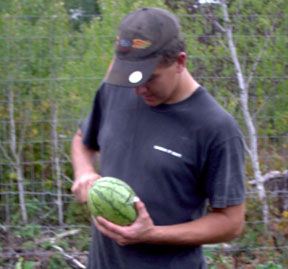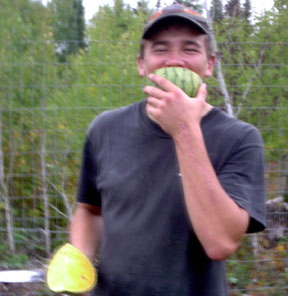Yes, it’s kind of sad, going down to our frozen garden that bit the dust last week after a night of 24 degrees. All the tomato vines are shrunken and black, hanging dejectedly over the edges of their cages. The corn stalks are all yellow brown and dry. The squash and watermelon vines are nearly gone, they’re so black and frozen. But here and there is still a sign of food. Two nights ago, I left the garden gate open and a deer wandered in; actually it was two deer, a doe and fawn. Then nibbled on the Swiss chard leaves, a few tomatoes, the dead beans, then went down and snacked on a few of the too-small-to-be-ripe watermelons and muskmelons.
But wait! There were some that were red and yellow inside the rind the deer left. So I reached down and grabbed another one about the same size and ripped it apart with my hands. It was glowing yellow (it was a Yellow Doll ice box melon). So I stood there sucking juice, biting into that crisp, cold, oh-so-sweet watermelon. Juice ran down my chin, smeared on my cheeks as I spit seeds and happily ate it all myself! Talk about ambrosia.
So I mentioned it to David and he had to make a stab at finding himself a watermelon. And the first one he picked was also very ripe. Although frosted and definitely non-keepers, his melon was drippy sweet too. He ate his treat, then we walked through the garden finding other treasures.
There are still some unfrozen green tomatoes left that were hiding when we picked the garden. Visions of green tomato mincemeat and green tomato pie came instantly to mind. I’ve got bushels of ripening tomatoes already in the house, but these are a bonus.
Today I made 8 pints and 8 half pints of chipotle salsa from the first batch of ripe tomatoes that ripened indoors. And boy was THAT good! Tomorrow I hope to get a batch of sweet watermelon rind pickles made up. Mmmmm. Those sweet, spicy pickles are oh so good.
 We also found that our rutabagas are HUGE this year. I’m talking about the size of a soccer ball on down. And the parsnips are getting nearly big enough to pull. But I like to leave them in till the ground threatens to freeze. In milder climates you can leave them in the ground all winter, but here they freeze in and when you pull them in the spring, the roots are all hairy. The carrots are also getting some size on them. Carrots don’t like hot weather and that’s all we had this summer, along with no rain.
We also found that our rutabagas are HUGE this year. I’m talking about the size of a soccer ball on down. And the parsnips are getting nearly big enough to pull. But I like to leave them in till the ground threatens to freeze. In milder climates you can leave them in the ground all winter, but here they freeze in and when you pull them in the spring, the roots are all hairy. The carrots are also getting some size on them. Carrots don’t like hot weather and that’s all we had this summer, along with no rain.
Our garden has been so good this year that I’m having to buy more pints and half pints! Not that I’m complaining. The pantry is looking oh so good and hunting season is right around the corner. I have a wall hanging in my kitchen that says LET US BE TRULY THANKFUL!
And we are.
I’ve posted readers’ questions and answers below:
Adding Salicylic Acid to peppers?
Can I add 25 grams of Salicylic Acid to one bushel of hot peppers, when I grind them? Someone told me that it preserved them better. I read the cautions on the bottle, and it says that it shouldn’t be swallowed.
Julie Francisco
East Providence, Rhode Island
Skip the salicylic acid. If you process the peppers right, you won’t have any worries about them keeping. I add nothing to my peppers other than vinegar, sometimes salt and spices. They always are fine. — Jackie
Homesteading dreams
I’m a city slicker (Chicago) who has had enough of the noise, congestion, and people of a big city and I’m planning to buy property (possibly Maine) and move ASAP. I’ve started volunteering on an small organic farm in Spring Green Wisconsin (to gain experience) – and I love it. I have also started buying books on small scale organic farming. Here is my question: I have had gardens in the past, so I know a bit about growing veggies. But the more I read, the more overwhelmed I get. What is your advice to someone who is going to make the leap with some but not much country living experience? My goal is to be as self reliant as possible and grow as much of my own food as possible. I plan to have some chickens for eggs (protein). I plan to get something with a field or two to grow some wheat (or whatever) animals eat…but most of the property will be wooded. Any basic steps you would take if you were in my shoes? Anything to avoid?
Ken James
Chicago, Illinois
Congratulations! I was born in Detroit and have never been back. In fact, I haven’t lived even close to a small town, let alone in one, since then, either.
First of all, try to pick the best place for your new homestead. This isn’t as easy as it sounds; but it isn’t all that hard, either. I’ve always tried to find a place that has some cleared land for pasture and gardens; it’s a daunting job to clear out big woods for these things, believe me! Find land that is not too low; it’s hard to put in a septic on low land, as it’s hard to garden or build as well. Any land can be homesteaded, but it’s a lot easier if you have decent soil to start with. We’ve homesteaded land that was red clay, rocks and high desert. But then it would have been easier and nicer if it was fluffy black dirt!
Get and read the BHM anthologies and a few gardening/homesteading books. Carla Emery’s Encyclopedia of Country Living is a real good one, covering just about anything you’d have questiions about. Read my blog and send in questions as you have them. I’ll always try to help you.
But don’t worry too much. Thousands of people have been in your shoes and have made the switch successfully. Go slow at first and learn a little at a time. It’s not rocket science, although some “experts” make you think it is….so they seem smart, maybe? There are different ways of doing things; all of which work. So when you get conflicting ideas, weed ’em out and decide what will work for you. For instance, some people swear only raised beds and intensive gardening is worth the effort. Others have used rows for years. Still others, me included, use a combination of wide rows, raised beds AND rows.
The “secret” of a good garden is to improve the soil any way you can, keep down the weeds, start cold sensitive plants inside and transplant out when the frost danger is over and to water deeply yet not leave the plants soggy.
Good luck and happy homestead dreams!!! — Jackie
Floating peaches and pears
I love to hot bath my peaches and pears but they seem to float to the top of the jar. I have tried packing them as tight as possible without bruising the fruit, but they still float to the top! This happens to my pickled beets also. What am I doing wrong, or what should I be doing?
Ara Anderson
Gillette, Wyoming
To prevent your fruit and pickled beets from floating to the top, heat them in the syrup/brine before you pack them. If you hot pack them, they won’t float when the jars cool. Floating fruit is not a problem, other than the looks. Tomatoes do this too. You’re doing nothing wrong. — Jackie


